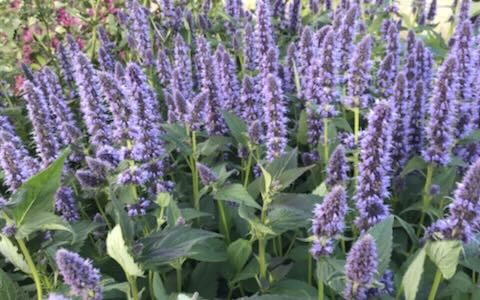- Out-of-Stock



Terrific long flowering agastache, distinct from Blue Boa with narrower conical flowers and more blue in colour. Prefers open drainage and good soil, as per other agastache.
Terrific long flowering agastache, distinct from Blue Boa with narrower conical flowers and more blue in colour. Prefers open drainage and good soil, as per other agastache.
Data sheet
One of the best achillea for foliage structure, the flowers are at their best pre colouring when the combination of grey flower buds and silvery foliage provide a lovely texture amongst summer perennials.
Pink form of Salvia nemorosa, best suited to bedding and mass plantings for bold colour effect during summer.
Lovely fluffy flowering texture in summer providing great fill and a soft contrast. A great grass all round and in early stages grows much like 'Karl Forester' until flowering time, when it looks very different; responds best in heavier fertile soils, and to date doesnt seed here.
An unusual bi-coloured iris with beautiful light blue flowers quite unlike anything I have ever seen. Imported from Cotswold Garden Flowers in 1999.
Rich pink variety, easy cottage garden plant flowering in autumn. Combine with ornamental grasses and sedums.
Variation of the usual blue forms, this one likes similar damp conditions in shade, forming a low spreading groundcover
Rare white form of the usual blue, useful for ground cover in part shade or sun. Vigorous and spreading like the blue form.
Our own variety which we have multiplied from division, flame orange fading into chesnut brown.
Strawberry coloured blooms with for a sheltered morning sun position or shade, a beautiful variety that doesnt self seed as much as the usual types.
A brilliant cushion forming plant, abundantly flowering in spring and early summer. We like to use these for path edgings and foreground plantings with dianthus and armeria. Best in friable soil.
Rich pink form of Phlox paniculata, lovely upright tall flower stems, variety originally distributed by Frogmore Gardens. One of the more vigorous varieties but like all paniculata types, loves fertility and good soil with plenty of summer moisture!
Low growing plant for shade or part shade, with spreading ground covering habit and porcelian blue flowers. Prefers open textured soil and easily divided once established, combines well with other woodland plants like anemone, rodgersia, and epimedium.
A terrific compact form of artemesia popular in mediterranean gardens, similar to 'Powis Castle' in silver foliage effect but finer and less shrubby, more suitable amongst perennial plantings.
Lower growing hosta with lots of lilac flowers and good rosettes of blue grey foliage. Useful variety for foreground plantings in part sun to shade.
A recent introduction by us is this sedum from my mothers garden, with white flowers, which is an unusual colour in the world of sedums! As with other sedums, easy to grow in full sun position in most soil types. Rarely but occasionally these can produce a pale pink sport, which should be removed with a sharp knife at the crown at the time of flowering.
Tall Phlox paniculata type, soft pink flowering in summer, best on fertile moisture retentive soil with astrantia, delphiniums and herbaceous perennials.

Terrific long flowering agastache, distinct from Blue Boa with narrower conical flowers and more blue in colour. Prefers open drainage and good soil, as per other agastache.